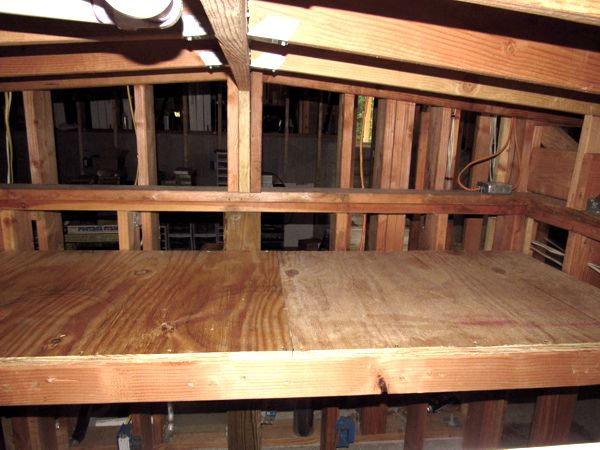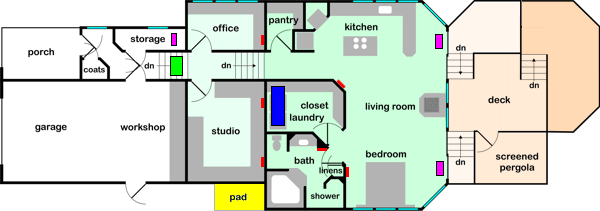HVAC
I evaluated many different forms of heating and air conditioning for my home, and indeed that research continued even after construction began. Initially I was looking at geothermal—it was recommended by my architect, and I liked the idea as it's considered very "green." It remained my plan up until I began researching various geothermal systems in earnest; then things quickly went south. Because I don't have a large treeless yard, I'd have to opt for a well-based system, which involves drilling two deep wells—and thus requires two deep pockets to cover the steep installation cost. With a payback period of up to ten years, I just couldn't justify that kind of investment.
It's just as well that I dismissed geothermal as an option, for I also learned that, while it may cool a house adequately, it doesn't dehumidify the air. I've read more than a few horror stories from homeowners who complained of mold, moisture damage, and other issues. Even if geothermal was more affordable, I would never tolerate problems like that, especially since excess humidity would negatively impact my main hobby.
The next option I considered was radiant heat, using a propane-fired hot water system. But this was quickly dropped owing to multiple problems: in my area, propane would actually be more expensive per BTU than electricity. And many people report that radiant heat has some significant drawbacks, such as an inability to respond to rapid fluctuations in temperature, as well as system maintenance issues. Plus, I'd still need a conventional air conditioning system for cooling, which would mean ductwork on top of a ton of plumbing.
I'd also briefly thought about resorting to an "old fashioned" forced hot air furnace, with a pair of "split" heat pump AC-only units, as this would involve the lowest up-front costs. But this kept bringing me back to the highly volatile price of oil and propane. I'd even considered "alternative" forms of heat, such as pellet stove systems, but these are more costly and complex to build, and weren't practical for a whole slew of reasons, not the least of which was the need to constantly feed them, as well as being at the mercy of fuel availability.
Finally, I began researching heat pumps for heating and cooling. A couple of close friends advised against it, claiming their experience with it was less than satisfactory. However, I volunteer at a facility that's heated and cooled with a heat pump, and it's perfectly comfortable all year—not to mention that it dehumidifies in the summer. I suspect it's a function of installing a properly-sized system. But the final selling point for me was how economical heat pumps are both to purchase and operate.
My home is quite small, with less than 800 square feet of heated space, so I don't need a monster HVAC system to begin with. Also, I'll have a wood stove in the main living space, where extra heat—if it's required—would be needed most. As an added bonus, the windowed living space faces southwest, so there should be a measurable amount of passive solar heating on sunny winter afternoons (more details below). Consequently I have no qualms about choosing a heat pump system.

The interior blower unit is tucked in an alcove built over the laundry (above), placing it centrally in the house (below, in blue) to maximize its efficiency by being in a semi-heated space with the shortest practical ductwork runs to all of the registers. And there's a concrete pad outside only about 12 feet away (yellow) for the compressor. BTW, there are only nine heat registers (floor in red, ceiling in magenta); the main air return intake (green) is located at the highest point in the house, since heated air will naturally rise there. So, as you can see, it's a pretty simple system.

Following the guidelines regarding "tight" houses, I added an exhaust fan in Kitty Central to create negative air pressure in the living space; this air is drawn through the kitty door near the floor—the perfect spot, since it will be the coolest air. An air intake (located in the pantry) connected to the HVAC system provides the supply of fresh air to the house.
I would like to be "greener," but living in the woods precludes any sort of active solar-powered system. Besides, the trees help cool my house—by 6-8 degrees—so I'm saving some energy right there. And the house is 100% electric, so aside from an occasional fire in the wood stove, I'm not personally generating any CO2.
But there's another factor in all of this that's not a function of house size or system efficiency, but simply a matter of practicality: it's the time I have left remaining on Planet Earth. Some systems take decades to realize a payback on the investment; I don't have much more than just a couple of decades left in my life, so investing in something that won't pay back in my lifetime makes no sense.
Ductwork
Just as with electrical wiring and plumbing, I enjoy building an HVAC system. But unlike the electrical and plumbing systems for the house, I didn't have plans already laid out before going to work, because I didn't nail down what type of system I'd be using until the house was already under construction. Ultimately I made things up as I went along, which necessitated a number of minor structural revisions.

Note that I'm using rigid ductwork: just as I prefer copper over plastic for water supply plumbing, I prefer galvanized steel over flexible plastic for ductwork. Yes, I could complete the whole system in an afternoon using plastic, but there are aspects of it I don't care for, such as its propensity to collect dust and dirt in the ribs, and the need to provide continuous support. But above all, I feel satisfaction going though the design and assembly processes. Below is the space for the blower, ready for its installation.

Here's the enclosure on 2 October 2019:

Passive Solar
One of the happy accidents about the house is its orientation: it faces southwest toward a clearing over the Red Fox Ravine, a.k.a. The View. This direction could not be more perfect, since it provides quite a bit of passive solar energy. The image below offers a sense of the natural light that floods the main living space in the late afternoon, which is especially welcome—and more intense—in winter months. I'm currently looking for bi-color window blinds to enhance the effect: a dark color on one side to absorb light in the winter, and a light color on the other to reflect it in the summer.

Factoid: What's a Heat Pump?
A heat pump is basically an air conditioner that can run in reverse. An air conditioner transfers heat from the inside to the outside by means of a compressed refrigerant. A heat pump can also transfer heat from the outside to the inside by the same means—even when it's very cold outside—simply by reversing the flow of the refrigerant.
There are other types of heat pumps; some transfer the heat using air, others with water. Geothermal systems are actually heat pumps in principle, using water to transfer heat to or from the ground instead of the outside air, which is much more energy-efficient. Refrigerant-based heat pumps are not as efficient, but their installation cost is significantly lower.
How's It Working?
By November 2019 the weather was such that the heating aspect of the system could be tested (cooling in the summer was 100% and could not be improved). Performance has been adequate, although a wood stove will absolutely be required in the dead of winter to supplement it. The main living space benefits from the ceiling fan running in the up-draft mode to better circulate warm air. The foyer is more than adequately heated by waste heat rising up The Grand Gallery from the main living space (as expected). The studio is comfortable with the heat registers fully closed, since it appears enough warm air leaks past them to keep the space warm, while the office is perfect. Bottom line: while it could be a bit better, it's still fine. The only way to improve it would be to completely re-engineer and rebuild the entire system, which obviously won't be happening. So, not bad considering I'm not an HVAC expert.
